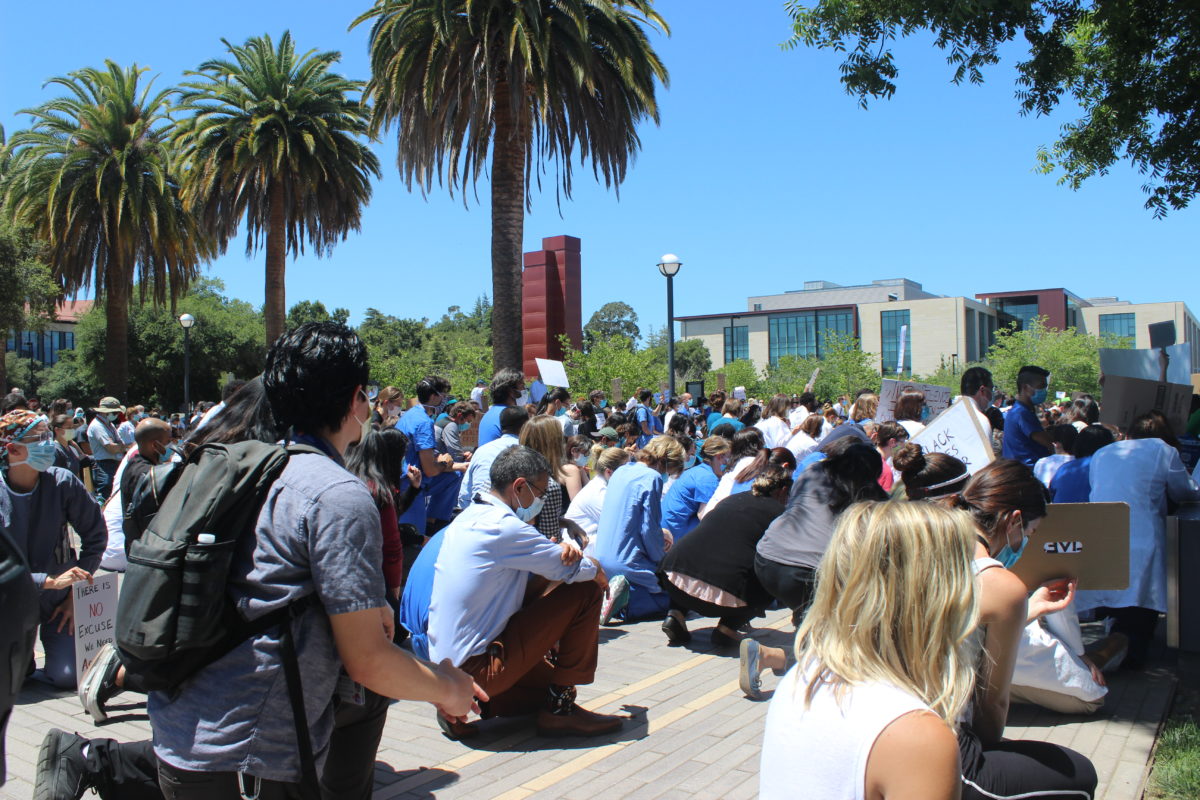The Stanford Medicine community rallied against police brutality and anti-Black racism on Thursday afternoon, joining the many protests taking place locally and nationwide after the death of George Floyd on May 25.
Organizers from the Stanford Pediatrics Residency Advocacy Council addressed the crowd. Pediatric resident Salma Dali led the crowd to kneel in silence for eight minutes and 46 seconds, the length of time a white police officer knelt on George Floyd’s neck in what has been charged as second-degree murder. Pediatric resident Kamaal Jones shared a story of being racially profiled by a police officer and urged the crowd to continue fighting racism as a community.
From 12:15 p.m., a crowd filled the majority of the plaza in front of the Li Ka Shing Learning and Knowledge Center, wearing facemasks and holding signs of protest. Families joined students, faculty and healthcare workers, some still dressed in scrubs and whitecoats.
“It starts right here for us as a medical community here at Stanford,” Jones said to applause. “We have to have anti-racism as part of education at every level. For our nurses, for our pharmacists, for everyone, they need to understand the history of it. We also have to reach out to the community and perhaps lean on our very hefty community benefit funding to help fund anti-racism.”
After the speeches, protesters marched back to Stanford Hospital chanting “Black lives matter” and “No justice, no peace.” The demonstrations on Stanford Medicine’s campus happened concurrently to another protest event organized by graduate students in front of Main Quad.
After the rally, members of the Pediatrics Advocacy Council told The Daily they planned to continue campaigning, and called for further change at Stanford Medicine.

“I want to emphasize that this is our first step in our greater commitment to anti-racism work in the pediatrics residency and also throughout the Stanford community,” said pediatric resident Simran Gambhir. “We wanted this to be a show of solidarity and also a very visible commitment to the work that we’re going to do, and we’re hoping to put out an email within the next few days with really specific tangible ways that we’re holding ourselves accountable, and we would expect other members of the Stanford community to do the same.”
Gambhir called for a “formalized anti-racism curriculum throughout the Stanford Medicine campus,” “more Black faculty hires and more Black trainees recruited” and for “Stanford Medicine to offer a larger commitment to the surrounding communities of color.”
Pediatrics resident Anu Gorukanti said Stanford should issue a “formal acknowledgement” about “the role that it’s played in some of the systemic inequities that exist in the incredible income equity and racism that exists in the Bay Area.” Gorukanti called for broader changes on Stanford’s campus.
“I think [Stanford should consider] including in its mission statement and value statements of commitment to anti-racist work, and to critically think about campus police and considering defunding campus police and [use] the opportunity to create crisis intervention teams that maybe can more accurately reflect the response that’s required and interested by the community,” Gorukanti said.
“We recognize racism as a public health danger — a pandemic that has persisted for too long in our society and must be eradicated,” wrote Lloyd Minor, dean of the School of Medicine, in a statement to The Daily. “Stanford Medicine is committed to this fight, and we vow to work in partnership with the Black community to achieve meaningful change.”
Iris Gibbs, associate dean of M.D. admissions and a professor of radiation oncology, attended the rally and expressed optimism that Thursday’s activism, if continued, could build on Stanford Medicine’s attempts to promote diversity.
“I’m proud to say that for the class of 2020 we have nearly 40% of our entering class being underrepresented in medicine,” Gibbs said. “… I’m proud of that moment, but at the same token, I’ve also been a little bit scared until now [about] how will that community be welcomed … I see through this event that there’s enough momentum here to showcase to them that they are welcome in this environment. What we want is for that to continue.”
This article was updated to correct quotes from Gorukanti, who called for curriculum on anti-racism not advocacy, and Gibbs, who referred to Stanford Medicine’s 2020 entering class, not interns. The Daily regrets these errors.
Contact Daniel Wu at dwu21 ‘at’ stanford.edu.
